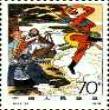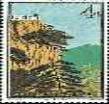 设为首页
设为首页
 加入收藏
加入收藏
教学设计示例Lesson 21
Teaching Aims
1.Words and phrases: cock, shame , coin , on the telephone.
2. Daily expressions:
1) Hello. Can I speak to Zhou Lan, please?
2) This is Zhou Lan speaking.
3) …but I’ve only just got home.
4) Would like to ask you about some stamps.
5) What a pity! What a shame!
6) I’ll ring you if I have any news.
7) It’s a pity I didn’t think of it earliest.
Step 1 Presentation
Show the Ss some stamps and talk about stamps or stamp collection by asking the Ss some questions:



1) What are these?
2) Do you like collecting stamps?
3) Have you got any valuable stamps?
4) Why do you like collecting stamps?
5) What else can we collect except stamps?
Tell the Ss today we're going to listen to a dialogue between Bruce and Zhou Lan. They are talking on the telephone about stamps. Please listen to the dialogue and find out what Brice wanted to get.
Step 3 Listening
1.Get the Ss to listen to the tape of the dialogue with the books closed.
2.Play the tape again and let the Ss repeat the dialogue .
T: Now let's listen to the tape again. When you listen to the tape, please pay attention to your pronunciation and read after the tape.
3.Ask them to answer this question: what does Bruce want to get? [A cock year stamp ]
Step 4 Reading
1. Get the Ss to read it in pairs. Then ask them some questions.
1)When did Bruce make a telephone call to Zhou Lan?
2)What happened to the cock year stamp Zhou Lan once sold?
3)What did Zhou Lan offer to do for Bruce?
Answers:1)late in the evening. 2)the week before3) help find one cock year stamp for Bruce.
2. Ask one or two pairs to act out the dialogue.
Step 5 Language points
1. Go through the dialogue briefly and make sure the Ss understand it.
2. Get the Ss to understand the following expressions and give them some explanations if Necessary.
1) It is a pity + that clause
It was a pity she didn’t ring me up yesterday.
2) Excuse me for doing sth.
Excuse me for ringing you so late in the evening.
3) I’d like to do sth.
I’d like to ask you some questions.
4) What a pity! What a shame!
A: I’m sorry I can’t join you in the travel.
B: What a shame! / What a pity!
Step 6 Practice 1
T tell Ss to read the dialogue again and complete the following dialogue.
A: Who ______ you ______ so late at night?
B: Bruce
A: What did he ______ you to do?
B: He ________ me ______ some stamps. He is very interested in ______ ______ ______ _______.
A: You have one, ______ ______?
B: I did have one, but I ______ ______ last week.
A: Do you think you ______ ______ ______ for Bruce?
B: Yes. I ______ to do so. I’ll ______ ______ as soon as I get one.
Step 7 Practice 2
SB Page 31 Part 2. Ask the Ss to make sentences in pairs. For example:
|
This/That That/There It’s Bob here. Is Bob there? This is Bob. Is that Bob? This is Bob speaking. Can I speak to Bob? |
Step 8 Practice 3
SB Page 31 Part 3. Work in pairs. Make up a dialogue that a foreigner Mr White wants to buy an old coin from his Chinese friend Mr Yang. The teacher let the Ss prepare a few minutes ,then ask two students to play in front of class. For example:
One possible version:
W: Excuse me for ringing you so early.
Y: That’s OK.
W: I would like to ask you for some Chinese coins. Do you have any old Chinese coins made in 1800AD? I would like to buy one.
Y: I used to have one, but I gave it to a friend last month.
W: Oh, what a pity!
Y: I’m sorry I didn't know you were interested in our coins. What a shame!
W: Never mind.
Y: Do you want me to find one for you?
W: Yes, please. That would be kind of you.
Y: Ok. I’ll ring you if I have any news.
W: Thank a lot. Goodbye.
Y: Goodbye.
Step 9 Homework
1. Finish off the exercises on Page 98.
2. Write down the telephone message of WB Ex. 2 in their exercise books.
教学设计示例Lesson
22
Teaching Aims
1.Word and phrases
shape, ring, collection, bank, material, hide, silver, penny (pi. pence), mine (n.) possibly, whenever, seashell, hand out, here and there, look round.
2.Useful expressions
1) …be of +n. = be + adj.
2) It is said that + subject clause
It is reported that…
It is believed that.
It is common to have the head of a famous person on one side.
3.Learn the history of coin.
Step 1 Revision
Revise the dialogue in SB L.21 by asking a pair of students to come to the front to act out the dialogue they themselves made.
T: First of all, I'll ask some of you to act out the dialogue you yourselves made after class.
A: Hello. Can I speak to …please?
B: This is … speaking.
A: Hello, …This is …. Excuse me for ringing you so late.
B: That’s OK.
A: I would like to ask you about some stamps. Do you still have …..stamp?
B: I’m afraid I don’t have it any more. I ……..
A: Oh! What a pity!
Step 2 Warm-up
1. Make up a dialogue between Ss and the teacher by asking these questions:
Do you like collecting things?
What do you collect?
How do you collect them?
2. Discussion: Put the Ss in groups of four to discuss these questions:
Which of the following do you collect: stamps, coin or postcards? Anything else?
3.Show the Ss some coins. Ask them who collect coin? How many coins have you collected? Tell the Ss something about coins.



T will tell them these coins are produced in 1999.
4. Talk about the picture on the top of page 32, using the following questions:
What can you see in the picture?
What are the shapes of these coins?
Say Today we're going to read a text about coins.
Step Listening and repeating
Play the tape of the passage for the Ss to listen and follow. Then ask them to do the following True or False Exercises.
1) The earliest coins in the world were used in China from more than 3000 years ago.
2) Coins may have the same designs on the two sides.
3) Before coins appeared, seashells, bamboo stick and wood were used for money.
4) The latest collection ever found in England was one of about 20000 silver pennies.
Step 3 reading
Get the Ss to read the passage carefully to know more information about coins. Then let them answer the following questions.
1) What were the earliest coins called?
2) When were the coins with holes in them used?
3) What is the coin usually pressed now? Was the date always included in the past?
4) What were the earliest coins in the west made of?
5) How many coins did the collection found in England in 1978 contain?
6) How did so many Chinese coins get to Australia?
Answers:
1) The earliest coin in China was called bei money.
2) These were used from 221BC until 1916.
3) Today the coin is usually pressed with name of the country, value of the coin and the ate. In the past the date was not always included.
4) The earliest coins in the west were made of gold mixed with silver.
5) It contained 54951 coins dating from the year 260 - 275AD.
6) It is known that thousands of Chinese worked in the gold mines in the late 19th century.
7) It is possible that one of them kept a kind of bank where the workers could keep their money safe.
8) Possibly this person died without anyone knowing where the coins were hidden.
Step 4 Language points
Write the useful expressions on the Bb. As usual, get the Ss to understand the following expressions.
1 ) with holes in it : The teacher comes in , with a book in his hand.
with + n. + 介词短语
In the cave I found a coin, with the design of a panda on its face.
with的复合结构,也可以作方式状语,用以修饰谓语动词。
2) Coins may be of different size…: Be of+ n..
Coins may be of different sizes的意思相当于Coins may be different in size.
3) be pressed with , be mixed with , be covered with….
4) in the late 1870s , in the early 1870s
5) It is …that + Subject Clause
It is known that…
It is possible that…
It is common to do …
Step5 Note making
Part 3.Page 33.Get the Ss to read the passage again and make notes. T check the Ss what information they have to put down.. Let the Ss work individually , then check the answers at the end of this activity.
Earliest coins: bei money from 650BC.
Information on the coin: name of country, value, and date.
Metals and other materials: gold, silver, seashells, wood and so on.
Designs: agricultural tools , head of a famous person, panda, and so on.
Step 6 Practice
Part 4, SB Page 33. This activity helps revise the - ing form as subject. Go through the example and the first two sentences orally and then let the Ss do this exercise alone. Check the answers with the whole class.
Answers:
1) Discovering so many Chinese coins in Australia is surprising.
2) Having the head of a famous figure on one side of the coin is rather common.
3) Getting used to the life in a foreign country needs time.
4) Handing out the listening text to the students seems necessary.
5) Reading without full understanding is no good.
6). Seeing her sad made me sad.
Step 7 Practice
1. SB Page 33, Part 5. Make sure that the Ss know the special use of the verbs in the exercise. Note that verbs like intend, continue, like, start are followed either by to do or the - ing. Write the following on the Bb: finish doing, allow doing, needs doing, advise doing, practice doing, suggest doing, can’t help doing, consider doing.
2. Let the Ss do it alone and check the answers with the whole class.
Answers:
1. rewriting 2. travelling/to travel 3. smoking 4. to buy/buying 5. washing
6. eating, taking 7. speaking 8. using 9. laughing 10. delivering 11. making/ to
make 12. smoking/to smoke
Step 8 Oral practise
Get the Ss to retell the whole passage according to the key words.
T: Now we have learnt about coins. We know the earliest coin, their sizes, weights and shapes. Let Ss retell the story according to the key words on the Bb.
Key words: the earliest coins, in China, different size, weights, shapes, …be made of different kinds of metal collections of coins that had been buried, tell a story.
Step 9 Workbook
Let the Ss to read the text once again. Then ask them to do WB Ex. 2 Page 99.
Step 10 Homework
Finish off the work exercises in WB.